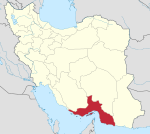
The Persian Gulf, sometimes called the Arabian Gulf, is a mediterranean sea in West Asia. The body of water is an extension of the Indian Ocean located between Iran and the Arabian Peninsula. It is connected to the Gulf of Oman in the east by the Strait of Hormuz. The Shatt al-Arab river delta forms the northwest shoreline.

The Strait of Hormuz is a strait between the Persian Gulf and the Gulf of Oman. It provides the only sea passage from the Persian Gulf to the open ocean and is one of the world's most strategically important choke points. On the north coast lies Iran, and on the south coast lies the Musandam peninsula, shared by the United Arab Emirates and Musandam Governorate, an exclave of Oman. The strait is about 90 nautical miles (167 km) long, with a width varying from about 52 nmi (96 km) to 21 nmi (39 km).
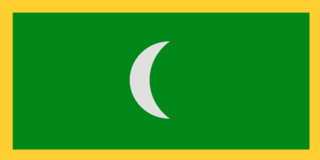
The Kingdom of Ormus was located in the eastern side of the Persian Gulf and extended as far as Bahrain in the west at its zenith. The Kingdom was established in 11th century initially as a dependency of the Kerman Seljuk Sultanate, and later as an autonomous tributary of the Salghurids and the Ilkhanate of Iran. In its last phase Ormus became a client state of the Portuguese Empire in the East. Most of its territory was eventually annexed by the Safavid Empire in the 17th century.

The Fifth Fleet is a numbered fleet of the United States Navy. It has been responsible for naval forces in the Persian Gulf, Red Sea, Arabian Sea, and parts of the Indian Ocean since 1995 after a 48-year hiatus. It shares a commander and headquarters with U.S. Naval Forces Central Command (NAVCENT) in Bahrain. Fifth Fleet/NAVCENT is a component command of, and reports to, U.S. Central Command (CENTCOM).

Hormozgan Province is one of the 31 provinces of Iran. It is in the south of the country, in Iran's Region 2, facing Oman, UAE and the Hormuz Straits. Its area is 70,697 km2 (27,296 sq mi), and its provincial capital is Bandar Abbas. The province has fourteen islands in the Persian Gulf and 1,000 km (620 mi) of coastline.

Bandar Abbas or Bandar-e ‘Abbās is a city in the Central District of Bandar Abbas County, Hormozgan province, Iran, serving as capital of the district, the county, and the province. Bandar Abbas is a port on the southern coast of the country, on the Persian Gulf.

In military strategy, a choke point is a geographical feature on land such as a valley, defile or bridge, or maritime passage through a critical waterway such as a strait, which an armed force is forced to pass through in order to reach its objective, sometimes on a substantially narrowed front and therefore greatly decreasing its combat effectiveness by making it harder to bring superior numbers to bear. A choke point can allow a numerically inferior defending force to use the terrain as a force multiplier to thwart or ambush a much larger opponent, as the attacker cannot advance any further without first securing passage through the choke point.

Qeshm is an arrow-shaped Iranian island in the Strait of Hormuz, separated from the mainland by the Clarence Strait/Khuran in the Persian Gulf. It is the largest island in Iran, and the largest in the Persian Gulf.

Minab is a city in the Central District of Minab County, Hormozgan province, Iran, serving as both capital of the district and of the county.
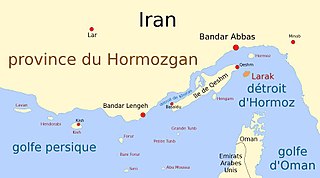
Larak Island is an island off the coast of Iran, which has been one of Iran's major oil export points since 1987. The narrowest part of the Strait of Hormuz at distance of 24 miles (39 km) lies between the island and the Omani-owned Quoin Island.

Hormuz Island, also spelled Hormoz, is an Iranian island in the Persian Gulf. Located in the Strait of Hormuz, 8 km (5 mi) off the Iranian coast, the island is part of Hormozgan Province. It is sparsely inhabited, but some development has taken place since the late 20th century.

Laft is a city in the Central District of Qeshm County, Hormozgan province, Iran. Laft is more than 2,000 years old. It is on Qeshm Island in the Straits of Hormuz, to the southwest of Bandar Abbas.

Jask is a city in the Central District of Jask County, Hormozgan province, Iran, serving as both capital of the district and of the county.
The Clarence Strait is a narrow strait separating the Iranian island of Qeshm from the Iranian mainland. It is the much smaller counterpart to the Strait of Hormuz. The native name for the strait is Khuran.
Bandar Sirik is a city in the Central District of Sirik County, Hormozgan province, Iran, serving as both capital of the district and of the county. It overlooks the Strait of Hormuz and contains a small harbour to the northwest of the main settlement.
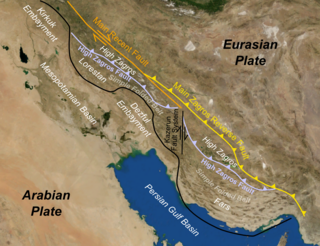
The Zagros fold and thrust belt is an approximately 1,800-kilometre (1,100 mi) long zone of deformed crustal rocks, formed in the foreland of the collision between the Arabian Plate and the Eurasian Plate. It is host to one of the world's largest petroleum provinces, containing about 49% of the established hydrocarbon reserves in fold and thrust belts (FTBs) and about 7% of all reserves globally.
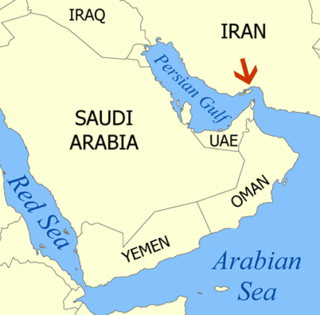
The 2011–12 Strait of Hormuz dispute was a dispute between a coalition of countries and Iran. The dispute arose on 27 December 2011, when Iranian Vice President Mohammad-Reza Rahimi threatened to close the Strait of Hormuz. In late April 2019 Iran said that it will block any shipping if it was barred from using the strategic waterway and in face of US sanctions

Iranocichla persa is a species of mouth brooding cichlid which was described in 2016 from the drainage basins of the Shur, Hasanlangi and Minab Rivers which flow into the Persian Gulf at the Strait of Hormuz in southern Iran.

Iran–Spain relations are the bilateral and diplomatic relations between these two countries. Iran has an embassy in Madrid, Spain has an embassy in Tehran.

The South Iran Nubo–Sindian desert and semi-desert ecoregion covers the northern coastal plain of the Persian Gulf and the inland desert hills south of the Zagros Mountains of Iran. The region also has extensions reaching into southeastern Iraq, and eastward into southwestern Pakistan. The region is one of hot sand deserts, shrubland, and open thorn woodlands inland. Mangrove forests and swamps are found along the coast.




















